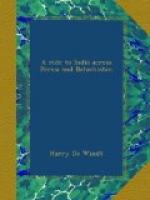But there seemed no probability of such a contingency. The sky was blue and cloudless, the sun so bright that the glare off the snow soon became unbearable without smoked goggles. The promise of an extra keran or two if we reached the end of the stage by daylight had a wonderful effect on the Shagird. Though it was terribly heavy going, and the snow in places up to our girths, we covered the five miles lying between Patchinar and the foot of the Kharzan in a little over three hours—good going considering the state of the road. We were as often off the former as on it, for there was nothing to guide one; nothing but telegraph poles and wires were visible, and these are occasionally laid straight across country away from the track.
Our destination for the night was the village of Kharzan, which is situated near the summit of the mountain, about six thousand feet high. The ascent is continuous and precipitous. An idea may be gained of the steepness by the fact that we now left the valley of the Shah Roud, barely one thousand feet above sea-level, to ascend, in a distance of about twelve miles, over six thousand feet.
The Kharzan Pass is at all times dreaded by travellers, native and European, even in summer, when there are no avalanches to fear, snow-drifts to bar the way, or ice to render the narrow, tortuous pathway even more insecure. A serious inconvenience, not to say danger, is the meeting of two camel caravans travelling in opposite directions on the narrow track, which, in many places, is barely ten feet broad, and barely sufficient to allow two horses to pass each other, to say nothing of heavily laden camels. But to-day we were safe so far as this was concerned. Not a soul was to be seen in the clefts and ravines around, or on the great white expanse stretched out beneath our feet, as we crept cautiously up the side of the mountain, our guide halting every ten or fifteen yards to probe the snow with a long pole and make sure that we had not got off the path.
A stiff and tedious climb of nearly seven hours brought us to within a mile of the summit. Halting for a short time, we refreshed ourselves with a couple of biscuits and a nip of brandy, and proceeded on our journey. We had now arrived at the most dangerous part of the pass. The pathway, hewn out of the solid rock, and about ten feet wide, was covered with a solid layer of ice eight or ten inches thick, over which our horses skated about in a most uncomfortable manner. There was no guard-rail or protection of any sort on the precipice side. All went well for a time, and I was beginning to congratulate myself on having reached the summit without-accident, when Gerdme’s horse, just in front of me, blundered and nearly lit on his head. “Ah, son of a pig’s mother!” yelled the little Russian in true Cossack vernacular, as the poor old screw, thoroughly done up, made a desperate peck, ending in a slither that brought him to within a foot of the brink. “That was a close shave, monsieur!” he continued, as his pony struggled back into safety, “I shall get off and walk. Wet feet are better than a broken neck any day!”




